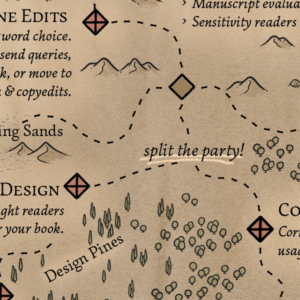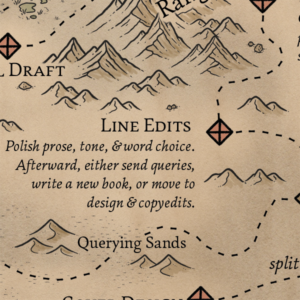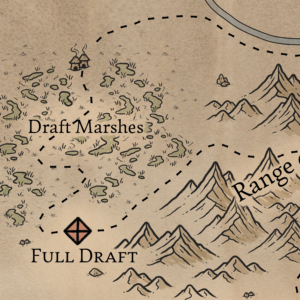 If you picked the self-publishing fork in the road after the Line Edit Foothills, it’s time to split your book journey party. You’ve got multiple quest objectives, and you can accomplish some of them at the same time if you plan it right. Right now you need to do two things: polish your manuscript and put together the graphic design pieces that make your book visually delightful. [Read more…] about Split Your Book Journey Party
If you picked the self-publishing fork in the road after the Line Edit Foothills, it’s time to split your book journey party. You’ve got multiple quest objectives, and you can accomplish some of them at the same time if you plan it right. Right now you need to do two things: polish your manuscript and put together the graphic design pieces that make your book visually delightful. [Read more…] about Split Your Book Journey Party
Fiction
The Line Edit Foothills
 On your book journey, you exit the Range of Revision and ease into the Line Edit Foothills. After conquering the larger mountains of character and plot, now it’s time to cross the rolling hills of cadence and prose. When the sun hits them just right, these hills sing.[1]Emperor’s New Groove reference 100 percent intended. [Read more…] about The Line Edit Foothills
On your book journey, you exit the Range of Revision and ease into the Line Edit Foothills. After conquering the larger mountains of character and plot, now it’s time to cross the rolling hills of cadence and prose. When the sun hits them just right, these hills sing.[1]Emperor’s New Groove reference 100 percent intended. [Read more…] about The Line Edit Foothills
References
| ↑1 | Emperor’s New Groove reference 100 percent intended. |
|---|
The Range of Revision
 Revising a manuscript is a journey through rough terrain. There are so many mountains to climb—character, plot, pacing, setting—and so many different ways to get through it all. That’s why the Range of Revision covers a big chunk of Looseleaf’s Book Journey Map. [Read more…] about The Range of Revision
Revising a manuscript is a journey through rough terrain. There are so many mountains to climb—character, plot, pacing, setting—and so many different ways to get through it all. That’s why the Range of Revision covers a big chunk of Looseleaf’s Book Journey Map. [Read more…] about The Range of Revision
The Draft Marshes
 Drafting a novel is no easy task. A full draft, no matter how messy, is a huge accomplishment. That’s why Full Draft is the first destination on Looseleaf’s Book Journey Map … and why you have to go through the Draft Marshes to get there. [Read more…] about The Draft Marshes
Drafting a novel is no easy task. A full draft, no matter how messy, is a huge accomplishment. That’s why Full Draft is the first destination on Looseleaf’s Book Journey Map … and why you have to go through the Draft Marshes to get there. [Read more…] about The Draft Marshes
Add Evocative Sensory Details to Your Scenes
Last week Looseleaf’s Kristy S. Gilbert was an editing special guest at the Life, the Universe, and Everything Symposium, and we’re going to post a few snippets from her panels. Today’s bit is from the panel “I Sense Something: Adding the Senses.” Excerpts are lightly edited for clarity (and some parts are summarized).
Stephen Gashler: Some sensory details we can readily identify with, like the color of a sunset—the pinks and the oranges—or maybe the barking dog in the distances. Some things are harder to describe, specifically the tasting and the smelling and feeling sensations. Given that some of these are overlooked what are some tips you have for describing some of these harder-to-describe sensations?
Michaelbrent Collings pulled out some tough love, pointing out that just because it’s hard doesn’t mean it isn’t important to your writing or worth the effort to learn. He also noted that you can use other sensory descriptions. Saying “the orange tasted bright and clean” uses some visual descriptions, but it describes flavor.
Kristy S. Gilbert: Along those lines, I also think—it’s not necessarily that you have to get the other person to know exactly what you’re talking about. Like when you say something is the pink of a sunset, it’s not so they know exactly what pink it is: it’s so you get the emotional note of a sunset into your scene. So I can say I went outside and the air smelled of dying worms—and that is the smell after a massive rainstorm, and all the worms come out, and they’re all dying, but I don’t need to spend a bunch of time being like, “Yeah, it’s that weird metallic smell/taste/thing you get after a long rainstorm.” I just have someone walk out, and the world is sopping wet and smells like dying worms. [Read more…] about Add Evocative Sensory Details to Your Scenes



